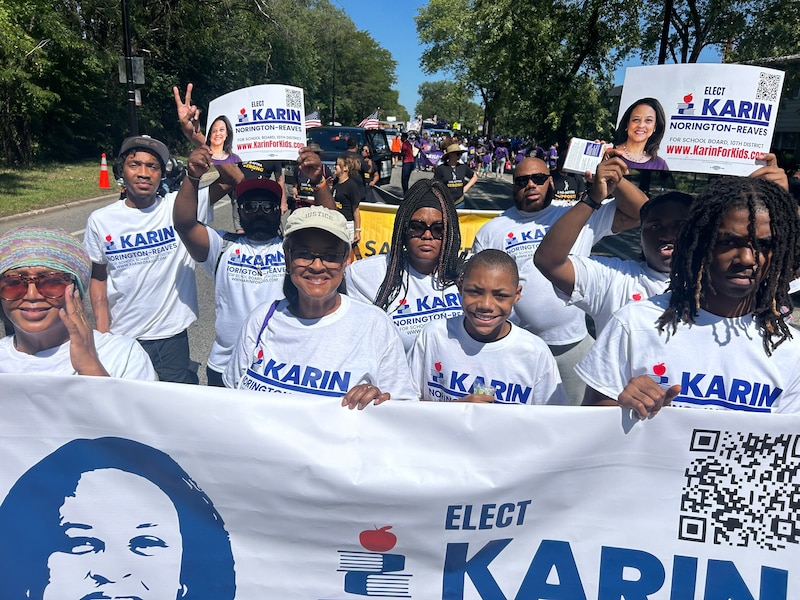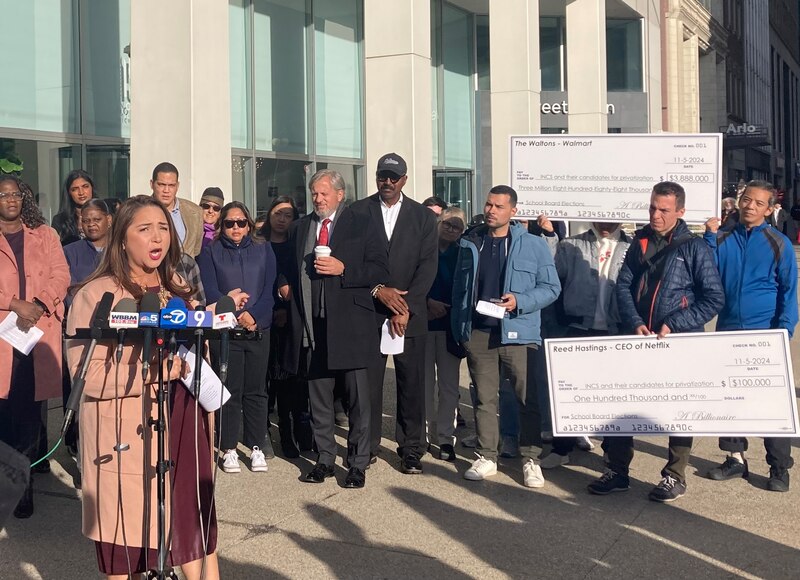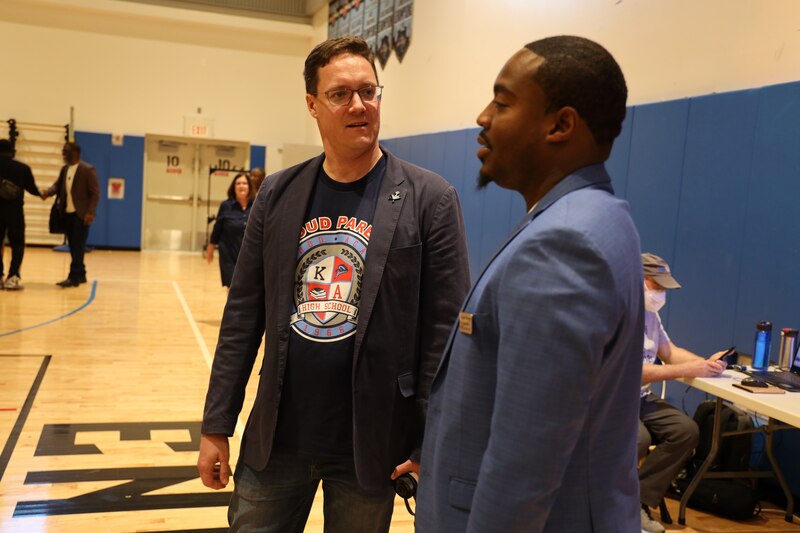Knowledge evaluation by Kae Petrin
Join Chalkbeat Chicago’s free each day publication to maintain up with the newest schooling information.
When Illinois lawmakers carved up Chicago into 10 areas for the metropolis’s first faculty board elections, one of many districts they created is a sprawling expanse that hugs town’s south lakefront from Soldier Area to the Indiana border.
District 10 has bustling high-performing faculties and shrinking campuses blocks aside. It has vacant buildings left behind from faculty closures and one of many highest common pupil poverty charges within the metropolis. However it’s also dwelling to a lot of Chicago’s political and enterprise movers-and-shakers, together with former President Barack Obama.
The primary candidates to declare their bids for Chicago’s new, partially elected 21-member board had been in District 10.
Forty-seven Chicagoans — together with 10 in District 10 alone — tried to run for varsity board. However simply 4 made it on the poll right here: Robert Jones, a pastor supported by the Chicago Lecturers Union who as soon as joined a starvation strike to maintain a neighborhood highschool open; Karin Norington-Reaves, a nonprofit CEO and mom of a blind CPS pupil who had run for Congress and obtained backing from pro-school selection tremendous PACs; Adam Parrot-Sheffer, a CPS mother or father, former district principal, and schooling marketing consultant; and Che “Rhymefest” Smith, a self-funded Grammy Award-winning rapper and activist.
Over the next six months, what performed out in District 10, in some ways, mirrored the dynamics and drama of the historic race throughout town.
On one hand, the election was a joyful, uplifting train in illustration — breaking with a long time of mayoral appointments to a largely rubber-stamp faculty board. On the opposite, the messiness of democracy was on full show, with reductive, deceptive soundbites and massive money flowing into the races. It was robust for newcomer candidates with out institutional backing or private wealth to hitch the race, together with the six individuals knocked off the poll in District 10.
Greater than $9 million was spent on mailers, adverts, and textual content messages praising or savaging the candidates, in response to a Chalkbeat evaluation of the newest marketing campaign reporting. Nonetheless, many citizens went into the poll field on Election Day not realizing that the college board race was even occurring.
As the brand new faculty board gears as much as take over in January and set requirements for a type of authorities new to Chicago, what are the teachings of town’s first ever faculty board elections? And what, if something, must be modified earlier than voters decide faculty board members once more in 2026?
‘A horrible solution to do democracy’

In early September, 9 weeks earlier than the Nov. 5 election, Che “Rhymefest” Smith sat on the abandoned higher stage of the Subterranean, the Northwest Facet music venue the place he’d lower his tooth as a rapper again within the Nineties. He was checking in together with his associate, Heather, and marketing campaign supervisor, Sean Tenner, earlier than a live performance to drum up assist and lift cash for Smith’s faculty board bid. The Smiths and their music studio had already loaned the marketing campaign almost $100,000.
That night, Smith, who unsuccessfully ran for alderman in 2011, felt pissed off with this newest foray into campaigning. He railed about “the transactional nature” of Chicago politics.
He needed to speak about issues like cracking down on wasteful district spending or placing partnerships with museums and nonprofits to spice up arts schooling. However as he met with organizations whose endorsements maintain sway with voters, they solely appeared to care whether or not a candidate had a path to victory. His self-funded marketing campaign gave the impression to be a turnoff; it made it more durable to purchase his loyalty, he suspected.
He was additionally nonetheless shaken by the expertise of getting on the poll.
First, would-be candidates needed to safe 1,000 signatures — a threshold some elected faculty board advocates stated was prohibitively excessive. In all, 47 overcame that hurdle. However then 27 of them ran up towards a frightening and bewildering staple of Chicago’s elections: petition challenges.
The Chicago Lecturers Union paid a set of election attorneys to characterize individuals difficult petitions in 18 of the circumstances, together with 5 in District 10. Smith and Norington-Reaves had been among the many candidates challenged by CTU proxies. The union additionally paid to fend off challenges to their endorsed candidates, together with District 10’s Robert Jones.
Smith challenged different candidates too, together with Jones. After a month of hearings and a overview by handwriting specialists, the 2 quietly agreed to drop their challenges towards each other.
The last-minute truce rattled Norington-Reaves, who amassed greater than 300 pages of voter affidavits and different proof to counter three challenges. She fired off a livid press launch, saying the race had been “marred by those that declare to assist consultant authorities however undermine it in the identical breath.”
Smith was relieved he had made it. However he felt uneasy concerning the unsavory observe of attempting to knock out the competitors.
“It’s a extremely horrible solution to do democracy,” Smith stated in a September interview with Chalkbeat. “All of us get caught up in a tangled internet of the political course of.”
However that evening, Smith brightened as he headed downstairs to kick off the efficiency. In a black baseball hat, black-framed glasses, and a white “Rhymefest for CPS” T-shirt, Smith instructed the gang that the college board controls the whole lot from what youngsters eat for lunch to how officers spend a $10 billion funds.
“These members would come from particular pursuits, enterprise,” he boomed on the mic, to a rumble of disapproval. “They didn’t actually come historically, traditionally, from our communities.”
‘Very low down on the poll’

A few weeks later, on an overcast Sunday afternoon in late September, Norington-Reaves strode down a quiet residential avenue on the far South Facet, glancing at a cellphone app the place orange dots represented the 200 seemingly voters she hoped to succeed in that day with a pair of staffers and a small group of volunteers.
She’d accomplished this earlier than in a high-profile race for Congress and was prepared with a cultured doorstep spiel.
When an 80-something man opened his door, Norington-Reaves began chatting about her expertise as a bilingual Train for America educator in Compton, California, earlier than a profession as an lawyer and a Chicago workforce growth official. She spoke about how she was impressed to run by her expertise attempting to line up faculty district providers for her daughter, a high-achieving pupil born with out eyes.
“If this was onerous for me, what’s it like for the common mother or father who doesn’t have the whole lot I’ve?” she instructed the person.
However the man, a retired trainer, was confused. Didn’t the mayor appoint the college board?
“How do you vote for members of the college board?” he requested.
Norington-Reaves had already participated in a dozen neighborhood boards concerning the faculty board elections and stuffed out quite a few candidate questionnaires. She’d spent eight hours or extra knocking on doorways each weekend. Chicago’s faculty board was within the information so much due to a push by the mayor and lecturers union to oust the district CEO. Regardless of all that, amid the high-pitched noise of a presidential election yr, most voters she spoke with nonetheless didn’t know concerning the faculty board race.
She defined to the person that the mayor would not decide all of the board members. By 2027, all could be elected.
“It’s very low down on the poll,” she stated. “I’m No. 103.”
“I promise I’ll vote for you,” the person stated.
Marketing campaign money flowed into the races
By early October, cash was flowing into and out of faculty board candidate marketing campaign coffers. At that time, the CTU was among the many largest spenders, serving to their endorsed candidates with area employees and different in-kind assist. Then the Illinois Community of Constitution Faculties unleashed a half one million {dollars} to assist individuals who favored faculty selection — doubling all spending to that time. Spending solely ramped up from then on.
Jones, the pastor at Bronzeville’s Mt. Carmel Missionary Baptist Church, turned one of many candidates citywide with the most important struggle chest, because of the CTU. He had related with lecturers union leaders in 2015, throughout a 34-day starvation strike he’d joined spur of the second to maintain Dyett Excessive College open. Now on the marketing campaign path, he typically introduced up the strike and echoed key union priorities, akin to increasing faculty staffing and a program referred to as Sustainable Group Faculties, through which campuses get additional funding to crew up with nonprofits and increase after-school applications, household engagement, and extra.

On a heat late October morning, he stood on the sting of a semicircle of elected officers, advocates, CTU members, and fellow faculty board candidates on a busy avenue within the Loop. The union had organized a press convention in entrance of the workplaces of the Illinois Community of Constitution Faculties to decry faculty board marketing campaign spending by the group, fueled by giant checks from rich individuals in and outdoors of Illinois. They had been calling for brand new marketing campaign finance limits.
On the occasion, State Sen. Robert Martwick, an architect of the 2021 legislation that green-lit an elected board in Chicago, vowed to push for such laws, maybe modeled on cities the place candidates solely obtain a restricted quantity of taxpayer funding to marketing campaign. He acknowledged a method of ushering in an elected board — and leaving the small print on how it might be elected for later.
The earlier week, Jones’ opponent, Norington-Reaves, had discovered a shiny flier in her mail that includes a faceless marionette in a go well with and tie, together with the message, “Donald Trump and out-of-state billionaires are pulling the strings of Karin Norington-Reaves.” She’d laughed. She was a lifelong registered Democrat who ran for Congress as a Democrat with then-outgoing Congressman Bobby Rush’s endorsement. To not point out she thought of Trump “essentially the most vile particular person in American political historical past.”
The deceptive mailer was paid for by the CTU, which justified it based mostly on the $250,000 spent by the Illinois Community of Constitution Faculties and one other tremendous PAC to assist Norington-Reaves. These tremendous PACs can pump limitless {dollars} within the race so long as they don’t coordinate with the candidates.
In the meantime, Jones additionally bristled at fliers that took his marketing campaign supplies and swapped out his photograph for the mayor’s, warning voters he was working to do Johnson’s bidding. The CTU’s backing was essential to his marketing campaign. The union had introduced in his area organizer, Abierre Minor, who pushed out textual content messages to voters and supporters with sign-ups for cellphone banking and canvassing. Greater than 40 volunteers had signed up. However Jones felt he was his personal candidate, a longtime supporter of labor that labor was now supporting again.
That October morning, Jones stepped as much as the mics. He spoke about his participation within the Dyett starvation strike. Then, glancing at notes, he stated, “Our kids are usually not on the market. Our faculties are usually not on the market. Our metropolis isn’t on the market.”
Concentrate on college students blurred by soundbites

Per week later, on a cool, cloudless Sunday morning, Parrott-Sheffer stood by the car parking zone of the Southside YMCA in Hyde Park, an early voting web site. When potential voters approached, he and a number of other marketing campaign staff for his opponents closed in. He pressed his marketing campaign bookmark into their arms.
“Adam Parrott-Sheffer, Kenwood Academy mother or father, 20-year educator, hoping to earn your vote,” he rattled off as some strode by briskly.
In March, Parrott-Sheffer turned the primary candidate throughout town to file marketing campaign finance paperwork. Since then, he had tried to be all over the place. He attended faculty registrations, parades, mornings on the farmers market. He sat on 21 faculty board candidate panels, stuffed out 25 questionnaires, and hung out on social media, “an previous man studying so much about TikTok.” He felt strongly the board wanted extra dad and mom and seasoned educators like him.
Nonetheless, Parrott-Sheffer knew he was a long-shot candidate. He’d by no means run for workplace earlier than and was handily outspent. He’s additionally a white man who was working for workplace towards three Black opponents in a predominantly Black district in a segregated metropolis whose political dynamics have been traditionally formed by race and ethnicity.
As Election Day approached, an increasing number of voters had requested the place Parrott-Sheffer stood on the mayor. Your entire faculty board had resigned underneath stress to fireside Martinez, the district CEO. Then, only a week after Johnson hurriedly hand-picked a brand new board, its new president resigned over antisemitic and misogynistic social media feedback.
The drama was not enjoying nicely with dad and mom and taxpayers, Parrott-Sheffer thought. It was giving non-CTU endorsed candidates like him a lift — however not that morning outdoors the YMCA.
A middle-aged lady dressed up in a pink jacket and lengthy white skirt stopped to listen to his spiel. Parrott-Sheffer began speaking about beefing up providers for college students with disabilities and English learners, the significance of creating certain college students can study by third grade, and the necessity to repair the district’s ageing faculty buildings.
The lady nodded approvingly after which lower him off: “Are you working with Brandon Johnson?”
“I’m not working with Brandon Johnson,” he instructed the voter that morning. “I’m an impartial candidate.”
She pulled again and frowned: “Why are you not working with him?”
Is that this what democracy appears like?
The District 10 candidates greeted Election Day with a combination of hope, pleasure, and unease.
Parrott-Sheffer felt he had given a strong marketing campaign his all. It simply saddened him that at a time when the college district confronted a management and monetary disaster, the advanced, nuanced schooling problems with the day had been conflated to neat soundbites, a nifty dichotomy: Have been you with the mayor and his mates on the CTU? Or had been you with the constitution individuals, which made you a Trump puppet, regardless of the customarily bipartisan nature of each assist and scrutiny of those faculties over time?
Smith felt his bid to solid himself as a changemaker had resonated with voters at a time of flux, even because the media and opponents hadn’t at all times taken him significantly. Norington-Reaves was worn out from months of juggling campaigning, a demanding job and motherhood, but additionally energized by honing her voice on the marketing campaign path. Jones had misplaced two belt loops door-knocking and speaking to voters, leaving him feeling extra related to his South Facet neighbors.
It could take till the Friday after the election for the Related Press to name the District 10 race for Smith, one of many closest within the metropolis. He led with about 32% of the vote, to Norington-Reaves’ 29%. Jones got here in third, and Parrott-Sheffer fourth.
As of Thursday, Norington-Reaves had not conceded, noting that 1000’s of mail-in and provisional ballots are nonetheless being counted. She has additionally threatened to sue the Chicago Board of Elections over points in District 10 and others the place election judges handed some voters ballots for the unsuitable faculty board districts.
The Chicago Board of Elections has acknowledged the difficulty however insisted it was mounted rapidly and chalked it as much as human error. In any case, the college board races had been new, and the electoral district boundaries drawn by state lawmakers six months earlier didn’t align with preexisting precincts and wards. However Norington-Reaves says the issue took hours to deal with in some precincts. “Doubtlessly 1000’s of voters had been disenfranchised,” she stated the Friday after the election.
Throughout town, candidates endorsed by the CTU — famed nationally for its means to place boots on the bottom and end up voters — confronted a surprisingly uphill battle. Three out of the 9 who had aggressive races prevailed, becoming a member of one, Jitu Brown, who ran unopposed, on the brand new board. Three candidates backed by the constitution community received their races, and so did three independents — all on the South Facet.
Cash had mattered throughout town — to some extent. In District 10, Smith spent about $5 and Parrott-Sheffer spent roughly $6 for every vote that they had earned, based mostly on marketing campaign finance information as of Nov. 12 and whole votes counted as of Nov. 14. Norington-Reaves and teams spending on her behalf had spent about $20 per vote whereas Jones spent nearly $27 per vote.
In keeping with the Chalkbeat evaluation, the CTU and a number of other allied teams largely funded by the union spent about $2.3 million. The constitution community and City Heart tremendous PACs spent roughly $3.5 million.
Longtime elected faculty board champions say town should reckon with the ups-and-downs of the races forward of 2026. Natasha Erskine, who leads the nonprofit Increase Your Hand, which noticed poll petition hearings, believes the signature threshold needs to be lowered. The hearings had been an train in “the Chicago means,” with some well-qualified candidates booted and people with extra assets having fun with a transparent edge.
The nonprofit, which fought for an elected faculty board for years earlier than the state legislation was handed, hosted “mini teach-ins” earlier than its candidate boards to teach them about what the college board truly does. It needs to see extra dad and mom and seasoned native faculty council members run. It additionally helps setting some limits on large marketing campaign spending.
“We had been anticipating it however, man, we weren’t anticipating that,” Erskine stated.
State Rep. Ann Williams, a sponsor of the elected faculty legislation, stated voter consciousness and pleasure concerning the election did rise over time, making the college board “the recent race” on the poll. She felt it featured many candidates wanting to have substantive conversations concerning the points — however who struggled to not be pigeonholed. Ellen Rosenfeld, a candidate backed by Williams, criticized the mayor and CTU but additionally put out a launch distancing herself from the pro-school selection cash spent on her behalf.
Williams feels the poll threshold is correct, noting that it’ll develop into 500 signatures in 2026 when the ten districts develop into 20. She and different lawmakers are open to proposals to finetune the method.
Within the meantime, Johnson is poised to nonetheless maintain sway over the college system as he should now appoint 11 members to the 21-member board by Dec. 16. However 5 newly-elected members are asking the mayor and his present board to train restraint by not taking any main actions till the brand new board is seated.
Within the days after the vote, Smith referred to as the opposite two impartial winners, Therese Boyle and Jessica Biggs. They wanted to band collectively forward of January, he instructed them.
Becky Vevea contributed to this report.
Mila Koumpilova is Chalkbeat Chicago’s senior reporter overlaying Chicago Public Faculties. Contact Mila at mkoumpilova@chalkbeat.org.

